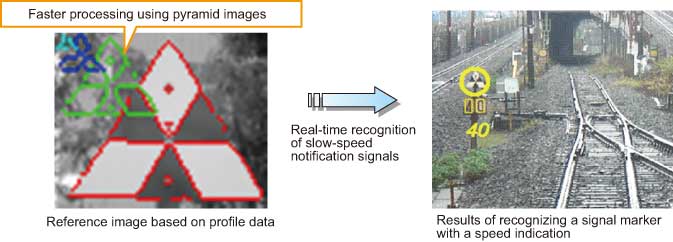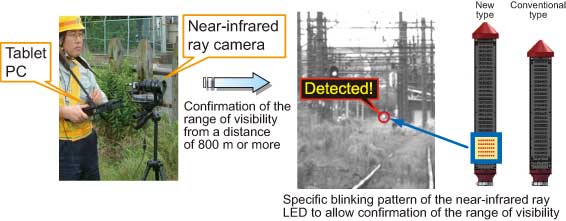4. An image processing system for recognition of special signals
- The RTRI developed an image processing technique for recognising slow-speed notification signals from inside vehicles.
- It also developed an obstruction warning signal that can confirm the range of visibility and a related recognition device.
The dependence of temporary signals, such as slow-speed indications, on drivers’ visual confirmation gives rise to the risk of oversight. Accordingly, the RTRI developed an image processing technique to allow the recognition of slow-speed notification signals, which are installed at a position about 500 m before the slow-speed signals themselves. With this system, it is possible to recognize slow-speed notification signals in real time using a pattern matching technique based on profile data for such signals. This approach has the advantage of being less influenced by variations such as the size and inclination of objects and sunlight than the conventional technique, which utilizes information on luminance. An on-track active duty test confirmed that detection is possible with a recognition rate of about 90% during the daytime, at night, and in fine and rainy weather (Fig. 1).
It is necessary for warning signals notifying of obstructions at level crossings to be continuously visible from a distance of 800 m. However, since it is difficult to visually confirm the level of visibility during train operation, a system or mechanism that can confirm the range of visibility even during the daytime is required. Accordingly, the RTRI developed a luminescent device fitted with an invisible near-infrared ray LED that blinks with a specific pattern and provided an image processing algorithm to recognize this pattern. Prototype apparatus was also developed that could be used to effectively confirm the range of visibility during the daytime, by means of a compact portable computer and a near-infrared ray camera that can be used on site. Performance testing during the daytime, at night, in fine and in rainy weather confirmed that a recognition rate of almost 100% can be achieved (Fig. 2). In the future, RTRI plans to study the system or mechanism further to enable continuous visual confirmation from inside vehicles.
 Fig. 1 On-board slow-speed notification signal recognition system
Fig. 1 On-board slow-speed notification signal recognition system Fig. 2 Obstruction warning signal visual confirmation system
Fig. 2 Obstruction warning signal visual confirmation system